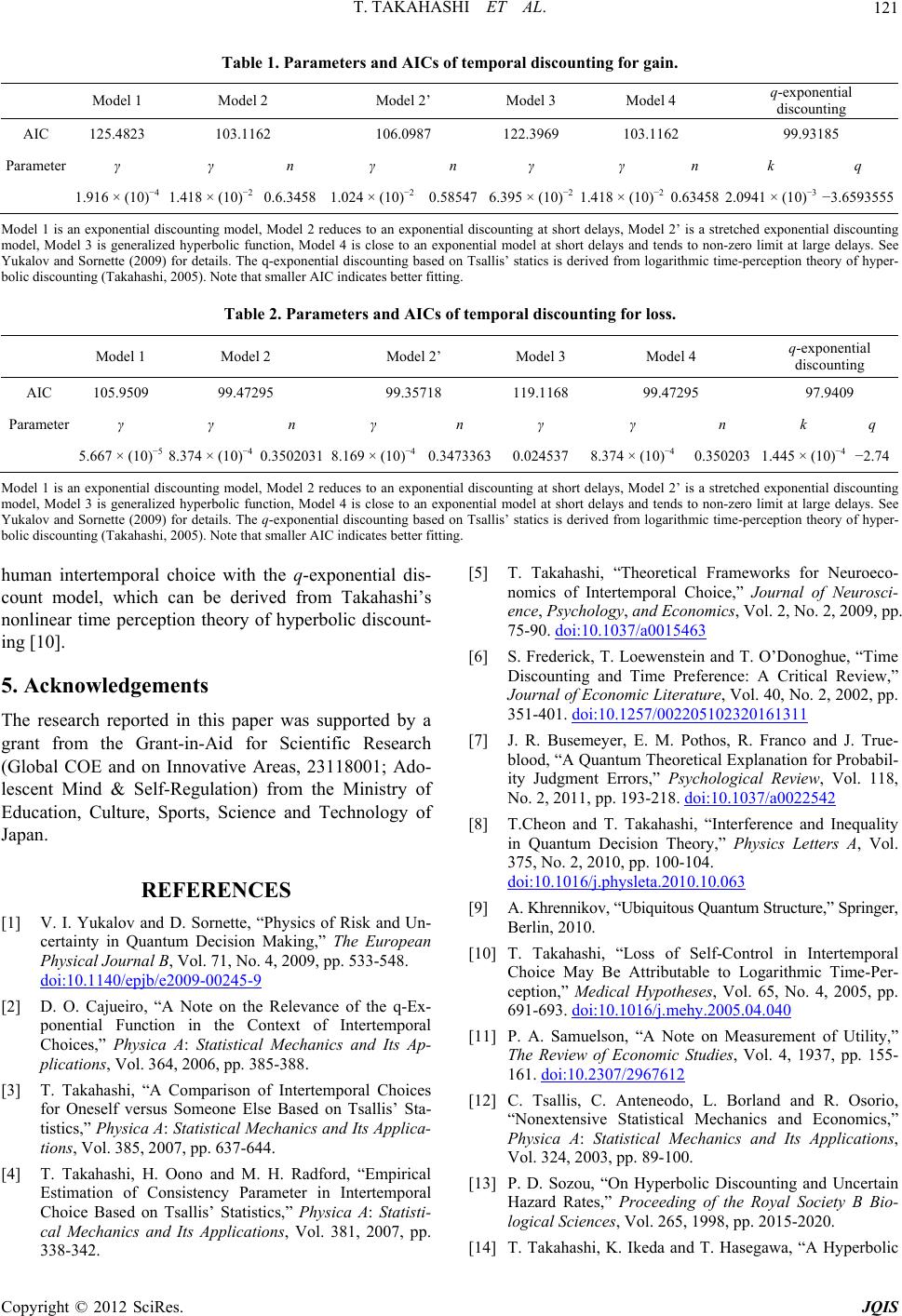
T. TAKAHASHI ET AL.
Copyright © 2012 SciRes. JQIS
121
Table 1. Parameters and AICs of temporal discounting for gain.
Model 1 Model 2 Model 2’ Model 3 Model 4 q-exponential
discounting
AIC 125.4823 103.1162 106.0987 122.3969 103.1162 99.93185
Parameter γ γ n γ n γ γ n k q
1.916 × (10)−4 1.418 × (10)−2 0.6.3458 1.024 × (10)−20.585476.395 × (10)−21.418 × (10)−20.63458 2.0941 × (10)−3−3.6593555
Model 1 is an exponential discounting model, Model 2 reduces to an exponential discounting at short delays, Model 2’ is a stretched exponential discounting
model, Model 3 is generalized hyperbolic function, Model 4 is close to an exponential model at short delays and tends to non-zero limit at large delays. See
Yukalov and Sornette (2009) for details. The q-exponential discounting based on Tsallis’ statics is derived from logarithmic time-perception theory of hyper-
bolic discounting (Takahashi, 2005). Note that smaller AIC indicates better fitting.
Table 2. Parameters and AICs of temporal discounting for loss.
Model 1 Model 2 Model 2’ Model 3 Model 4 q-exponential
discounting
AIC 105.9509 99.47295 99.35718 119.116899.47295 97.9409
Parameter γ γ n γ n γ γ n k q
5.667 × (10)−5 8.374 × (10)−4 0.3502031 8.169 × (10)−40.34733630.0245378.374 × (10)−40.350203 1.445 × (10)−4−2.74
Model 1 is an exponential discounting model, Model 2 reduces to an exponential discounting at short delays, Model 2’ is a stretched exponential discounting
model, Model 3 is generalized hyperbolic function, Model 4 is close to an exponential model at short delays and tends to non-zero limit at large delays. See
Yukalov and Sornette (2009) for details. The q-exponential discounting based on Tsallis’ statics is derived from logarithmic time-perception theory of hyper-
bolic discounting (Takahashi, 2005). Note that smaller AIC indicates better fitting.
human intertemporal choice with the q-exponential dis-
count model, which can be derived from Takahashi’s
nonlinear time perception theory of hyperbolic discount-
ing [10].
5. Acknowledgements
The research reported in this paper was supported by a
grant from the Grant-in-Aid for Scientific Research
(Global COE and on Innovative Areas, 23118001; Ado-
lescent Mind & Self-Regulation) from the Ministry of
Education, Culture, Sports, Science and Technology of
Japan.
REFERENCES
[1] V. I. Yukalov and D. Sornette, “Physics of Risk and Un-
certainty in Quantum Decision Making,” The European
Physical Journal B, Vol. 71, No. 4, 2009, pp. 533-548.
doi:10.1140/epjb/e2009-00245-9
[2] D. O. Cajueiro, “A Note on the Relevance of the q-Ex-
ponential Function in the Context of Intertemporal
Choices,” Physica A: Statistical Mechanics and Its Ap-
plications, Vol. 364, 2006, pp. 385-388.
[3] T. Takahashi, “A Comparison of Intertemporal Choices
for Oneself versus Someone Else Based on Tsallis’ Sta-
tistics,” Physica A: Statistical Mechanics and Its Applica-
tions, Vol. 385, 2007, pp. 637-644.
[4] T. Takahashi, H. Oono and M. H. Radford, “Empirical
Estimation of Consistency Parameter in Intertemporal
Choice Based on Tsallis’ Statistics,” Physica A: Statisti-
cal Mechanics and Its Applications, Vol. 381, 2007, pp.
338-342.
[5] T. Takahashi, “Theoretical Frameworks for Neuroeco-
nomics of Intertemporal Choice,” Journal of Neurosci-
ence, Psychology, and Economics, Vol. 2, No. 2, 2009, pp.
75-90. doi:10.1037/a0015463
[6] S. Frederick, T. Loewenstein and T. O’Donoghue, “Time
Discounting and Time Preference: A Critical Review,”
Journal of Economic Literature, Vol. 40, No. 2, 2002, pp.
351-401. doi:10.1257/002205102320161311
[7] J. R. Busemeyer, E. M. Pothos, R. Franco and J. True-
blood, “A Quantum Theoretical Explanation for Probabil-
ity Judgment Errors,” Psychological Review, Vol. 118,
No. 2, 2011, pp. 193-218. doi:10.1037/a0022542
[8] T.Cheon and T. Takahashi, “Interference and Inequality
in Quantum Decision Theory,” Physics Letters A, Vol.
375, No. 2, 2010, pp. 100-104.
doi:10.1016/j.physleta.2010.10.063
[9] A. Khrennikov, “Ubiquitous Quantum Structure,” Springer,
Berlin, 2010.
[10] T. Takahashi, “Loss of Self-Control in Intertemporal
Choice May Be Attributable to Logarithmic Time-Per-
ception,” Medical Hypotheses, Vol. 65, No. 4, 2005, pp.
691-693. doi:10.1016/j.mehy.2005.04.040
[11] P. A. Samuelson, “A Note on Measurement of Utility,”
The Review of Economic Studies, Vol. 4, 1937, pp. 155-
161. doi:10.2307/2967612
[12] C. Tsallis, C. Anteneodo, L. Borland and R. Osorio,
“Nonextensive Statistical Mechanics and Economics,”
Physica A: Statistical Mechanics and Its Applications,
Vol. 324, 2003, pp. 89-100.
[13] P. D. Sozou, “On Hyperbolic Discounting and Uncertain
Hazard Rates,” Proceeding of the Royal Society B Bio-
logical Sciences, Vol. 265, 1998, pp. 2015-2020.
[14] T. Takahashi, K. Ikeda and T. Hasegawa, “A Hyperbolic